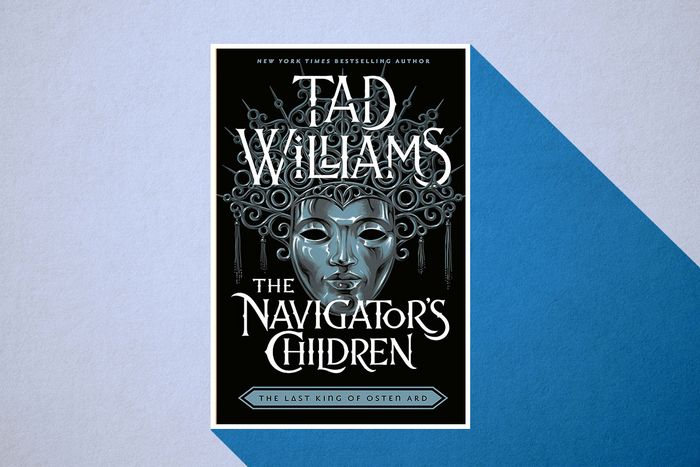
Spoilers for Memory, Sorrow, and Thorn and The Last King of Osten Ard below.
Eight years before George R.R. Martin published A Game of Thrones, Tad Williams released The Dragonbone Chair, the first installment in what would become a highly influential fantasy series called Memory, Sorrow, and Thorn. In 1988, when The Dragonbone Chair came out, the genre was not quite the juggernaut it is now; Dungeons & Dragons was the subject of fundamentalist panic, and “romantasy” was not yet a glimmer in a publicist’s eye. But there have always been nerds, and Williams’s books found their people — including Martin, who has said the series “was one of the things that inspired” him to write his own.
Memory, Sorrow, and Thorn consists of three massive books — originally four, as the last book, To Green Angel Tower, was split into a more manageable two volumes. Set in a world called Osten Ard, the series follows the granddaughter of a dying king, Miriamele, and a kitchen boy named Simon as they try to stop her corrupt father, Elias, from ascending the throne.
The Dragonbone Chair was a critical and commercial success, and when the series finale, To Green Angel Tower, came out in 1993, it made the New York Times best-seller list despite its enormous length. Memory, Sorrow, and Thorn proved there was an appetite not only for epic fantasy but for the complexity that Williams brought to the genre.
Kitchen boys with high destinies are common enough, but Simon’s adventures strike at the deepest myths of the empire he inhabits. In time, Simon discovers that the tale of Miriamele’s grandfather, Prester John, and his throne, the vaunted Dragonbone Chair, is based in part on a lie: The old king had never slain a dragon as he’d claimed. Instead, the dragon was killed by Simon’s own royal ancestor — and Simon himself later follows suit, killing another in the north. The world of Osten Ard is not morally ambiguous; there is right, and there is wrong. Compare it to Middle-earth, though, and it’s more gray than Tolkien’s black-and-white.
Though I’ve read and loved fantasy since I was a child, I didn’t hear of The Dragonbone Chair or its sequels until I was in my 30s, after browsing the internet to find classics I hadn’t read. I picked them up in 2020. My grandfather was dying of COVID, the world was locked down, and all was bleak. I flew home to be with my family as my grandfather passed, and I downloaded the first book because it is 800 pages long and wouldn’t fit in my suitcase. Then I devoured it. And its sequel, The Stone of Farewell, and its finale, To Green Angel Tower. In fact, I read the entire series in about two weeks. Soon, I learned that Williams had revisited this world in a new series, called The Last King of Osten Ard, which he began to release in 2017. The final book, The Navigator’s Children, came out earlier this November.
People sometimes claim that fantasy is about escape. I don’t agree. Memory, Sorrow, and Thorn opened up a new world as my own shrank, but I didn’t read the books to flee my own reality, and I don’t think they would have let me if I tried. The world that Williams built is not always as grim as our own pandemic era, yet it is beset by its own terrors. There are dragons and trolls in Memory, Sorrow, and Thorn, along with important swords and a race of long-lived elflike people called the Sithi, but Williams subverts the usual tropes. The trolls are not mindless antagonists but have their own society, and two in particular become great friends to Simon and Miriamele as they try to save Osten Ard from Elias and his evil adviser. The Sithi aren’t merely wise guides or mighty warriors, either. Their wisdom has limitations, they have reasons to resent mankind, and they are marked forever by strife with their cousins, the Norns. Royal or noble blood neither corrupts or sanctifies a person, and while prophecies exist, they can also mislead.
Though Memory, Sorrow, and Thorn ends with Simon and Miriamele on the throne of an empire, the new series questions the notion of empire itself. Miriamele and Simon are middle-age now, and their kingdom is in trouble again. When The Navigator’s Children opens, Miriamele and Simon are separated not by choice, but by war, and both believe the other to be dead. Their castle is on fire; the blackened hulk of the Dragonbone Chair is nearly all that remains. That’s “a dreadful jest,” as Miriamele puts it, because Simon, known as the “commoner king,” loathes the thing.
In The Navigator’s Children, absolute power corrupts all it touches. There is an enemy queen, Utuk’ku, to fight, and though she has inexplicable abilities, the underlying evil is the rage that consumes her and powers her total rule. Although she has loyal servants who prosper off slavery and exploitation, they are capable of independent thought and deed. Toward the end of the book, it becomes clear that Utuk’ku plans to destroy the world and with it, her own people. Death is a kindness, she tells them, because there is no future for them without her. The Navigator’s Children is as much a tale of emancipation as it is the exploits of Simon and Miriamele and their circle.
At nearly 800 pages long, the book is a commitment, but not a difficult one. Its readability owes much to Williams and his prose, which is lyrical but not cloying, and to his storytelling, which is propulsive without sacrificing character development or narrative tension. As a result, the world of Osten Ard feels lived-in, relatable even at its most alien. There are traces of Tolkien here, but Williams took the genre in new directions and continues to do so with The Navigator’s Children. With few exceptions, the villains are obviously and deeply flawed but not intrinsically evil and thus exist on the same moral spectrum as the heroes, who are good because of the choices they make rather than their destiny or lineage. A strain of anti-authoritarianism runs throughout Memory, Sorrow, and Thorn, and in The Navigator’s Children, it moves to the fore. By the end of the book, Simon and Miriamele have begun to dismantle their empire. They plan for their grandson, Morgan, to return power to the kingdoms conquered by Prester John, and there is talk of a council of nations. Democracy isn’t on the horizon, but they’re shifting away from imperial power toward a more cooperative future.
The Navigator’s Children isn’t social commentary, but no book exists in a void, either. I read it in another bleak moment, a week after Donald Trump won reelection. Our future, like that of Osten Ard, is ambiguous. To Williams, a wise ruler knows when to give up power, and he leaves readers to imagine what that new world might become. There’s something reassuring about that uncertainty. I don’t look to Williams — or to the fantasy genre — for easy comforts, and indeed there are none in Osten Ard. Instead I find a challenge, and that is useful now. When I feel the pull of despair, I remember the work of progress is long and uneven. Our happy ending might not be definite, but neither is our doom.
Williams had already established himself as a genre star well before the publication of The Navigator’s Children. He’s an international best-selling author, and by 2023, his collected works had sold over 30 million copies worldwide. As The Last King of Osten Ard concludes, he may be poised for even greater prominence. A television adaptation of his sci-fi Otherland series was in development as of last year. Studio interest in fantasy remains insatiable following the global success of HBO’s Game of Thrones, albeit with mixed results, so it’s not hard to imagine the panoramic Memory, Sorrow, and Thorn on screens someday. Whether they’re ever adapted or not, Williams is worth reading — especially when the hour is dark.
An earlier version of this post misstated the publication year of The Dragonbone Chair and the title of George R.R. Martin’s A Game of Thrones.


